Skill over brawn can be the key in effective self defence. If you know how to use pressure points on the body, you don’t have to be young or physically fit or possess great strength to disable an attacker. Self-defence has to do less with power and more with the element of surprise.
This was the central theme of a presentation and demonstration on the martial arts’ once-secret movements at the Sunday, September 28, meeting of the Pattaya City Expats Club; led by Scott Rohr, a highly successful student and practitioner of the arts of karate and taekwondo. To begin, Scott provided some background information about the origination of martial arts and then led the audience in an interactive demonstration of self-defence manoeuvres.
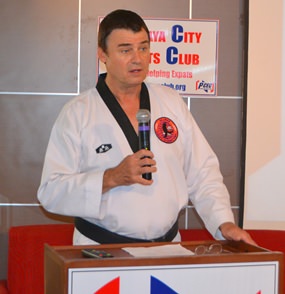 Scott Rohr explains to his PCEC audience that they can learn a few martial arts manoeuvres which can be used for self defence; they do not rely on strength, but on skill that can be learned without regard to age and gender.
Scott Rohr explains to his PCEC audience that they can learn a few martial arts manoeuvres which can be used for self defence; they do not rely on strength, but on skill that can be learned without regard to age and gender.
Originally from Portland, Oregon, Scott Rohr is now a 56 year old expat living in Pattaya. By the age of 17, Scott had earned a black belt in karate. He has since risen to the rank of 9th degree black belt in both Ryukyu Kempo Karate and taekwondo. With the assistance of Jim Jones, Scott teaches karate three mornings a week. Expats are welcome to participate. Interested persons should contact Jim Jones, who is present at most PCEC Sunday meetings.
Scott started studying martial arts in 1969 at the age of 12. In 1972, Scott began training with a Korean teacher in Portland, Oregon; Master Tae Hong Choi in the arts of hapkido, taekwondo and judo. In 1993, Scott began a student/teacher relationship with Karate Grand Master George Dillman of Reading PA. Dillman opened the door for Scott to long hidden neural pressure point knowledge in the iconic forms of karate (KATA).
Scott explained that contrary to popular belief, martial arts did not originate in China. They started in northern and southern parts of India, mixed in with natural medicine. They then expanded to other countries, including China. In the late 14th century, because many families from South China moved to Okinawa to handle a growing merchant trade, they brought the martial arts with them.
The practitioners of martial arts in Okinawa were court dignitaries, military officers, scholars and artisans. This was the genesis of both karate and Taekwondo. It would be another 500 years before Americans became involved. Scott explained that many American soldiers learned about KATA from the grandmasters when they were stationed in Okinawa at the end of World War II. However, the grandmasters possessed some secret moves that they did not impart to their American students.
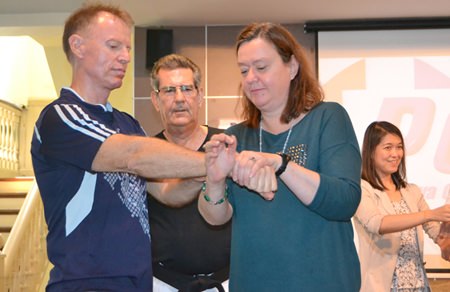 Jim Jones watches as members of the audience practice using pressure points for self defence.
Jim Jones watches as members of the audience practice using pressure points for self defence.
Many of these students opened karate schools when they returned to the U.S. The number of schools grew exponentially as a result of an influx of foreign teachers into the US after 1945. In the 1970s, Taekwondo spread rapidly after being heavily promoted by the Korean government. Some of the American students who had opened schools made pilgrimages back to Okinawa to see their teachers. The teachers were impressed with the progress their students had made and began to reveal some of the secrets they had kept from them.
George Dillman was able to learn these moves from several very old Okinawa grandmasters. Scott explained that when most people think of karate, they see self-defence moves that involve blocking, punching and kicking. But the secret, more esoteric movements involve learning the correct angle and direction to attack pressure points in the body’s nerves (known as the “neural” or “nervous” system). Attacking these pressure points is very effective, and can cause unconsciousness and even death. Scott said that this hidden knowledge profoundly changed his understanding of karate. Previously, Scott said, karate felt like carrying a gun with no bullets.
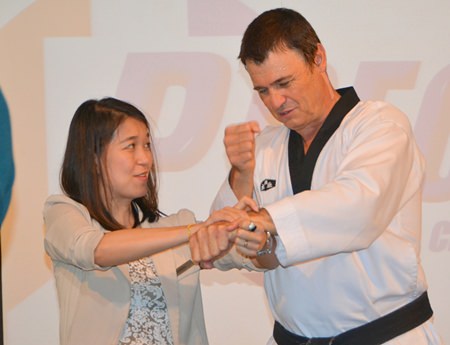 Scott Rohr demonstrates how to use pressure points to repel an attacker that grabs your wrist.
Scott Rohr demonstrates how to use pressure points to repel an attacker that grabs your wrist.
Scott explained that there are about 700 pressure points on the body, 350 on each side, and that martial arts use 30-40 of these points. The points are where nerves begin or end, and where they split. About 10 of the points are in the arm; two are in the wrist and one is in the hand. Scott showed the audience that there is a pressure point under the wrist that, when pressed, will immediately open up a fist.
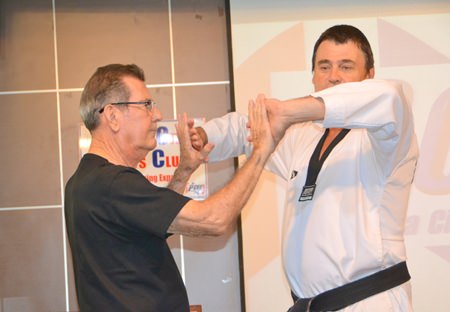 Scott Rohr is assisted by Jim Jones in demonstrating some martial arts characteristics.
Scott Rohr is assisted by Jim Jones in demonstrating some martial arts characteristics.
With the assistance of club member Jim Jones, who has studied martial arts and has a 2nd degree black belt, and with the participation of many members of the audience, he further described and demonstrated four situations where pressure points can be used to defend oneself from attack. The moves involved being grabbed by the forearm; being pushed against the wall and grabbed at the neck; dealing with an obnoxious and usually larger person putting his arms around your shoulder and pushing you around that way; and stopping a fist, slap or punch directed to your head.
Scott said that his best students are people in their 50s and 60s who are serious about wanting to learn self-defence. Further, that most people who learn self-defence skills are not likely to ever have to use them to ward off an attack. However, he added, the skills can be useful in other ways, such as learning how to fall without causing serious injury.
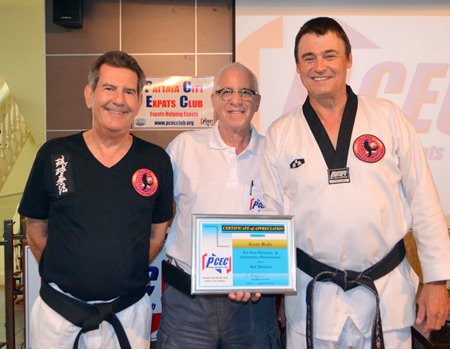 MC Richard Silverberg presents the PCEC’s Certificate of Appreciation to Scott Rohr for his presentation and thanks member Jim Jones for his able assistance.
MC Richard Silverberg presents the PCEC’s Certificate of Appreciation to Scott Rohr for his presentation and thanks member Jim Jones for his able assistance.
Master of Ceremonies Richard Silverberg then brought everyone up to date on upcoming events and called on Roy Albiston to conduct the always informative Open Forum where questions are asked and answered about expat living in Thailand, especially Pattaya.
For more information on the PCEC’s many activities, visit their website at www. pcecclub.org.




